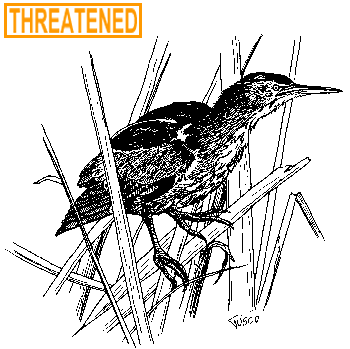Least Bittern
Ixobrychus exilis
Habitat: Emergent vegetation in freshwater marshes and occasionally saltwater or brackish marshes.
Weight: 1.5-4 ounces.
Length: 11-14.5 inches.
Wingspan: 16-18 inches.
Life Expectancy: Unknown.
Food: Small fishes, frogs, tadpoles, salamanders, leeches, slugs, crayfish, dragonflies, aquatic bugs and occasionally shrews and mice.
Status: State threatened.
Identification: The least bittern has buffy underparts, a white throat with yellow-brown on the sides of the neck, a slightly crested head, a slender, dull yellow bill, and yellow eyes. The crown and back are black in males and brown in females. The species also has a dark phase in which brown-red replaces all lighter colors of the normal phase. The most obvious characteristic for identifying the least bittern is its buffy wing patches. The song consists of low, muted "coo's."
Range: The least bittern is found from northwestern North America and southern Ontario to New Brunswick, extending south through the tropics.
Reproduction: The least bittern usually breeds in freshwater marshes, starting in early June. The nest, which is constructed by both adults out of dead and live plant stems, is a platform with a shallow hollow. It is placed about a foot above water, usually on the base of dried plants. The 4 to 5 eggs are smooth, dull and pale-blue to pale-green. They are usually laid at daily intervals and incubated by both sexes, beginning with the second egg. The young are tended by both adults and leave the nest 5 to 14 days after hatching.
Reason for Decline: This secretive bird has been adversely affected by the draining and filling of wetlands.
History in Connecticut: Historically, the least bittern was a regular summer resident. The species was particularly abundant throughout Connecticut during the mid-1870s. However, from 1896 to 1910, there were only 8 reported sightings of this species, leading experts to describe it as a "rather rare" summer resident. The least bittern continues to be absent from most parts of the state.
Interesting Facts: Although the least bittern is not considered a strong flier, it does migrate to open water in the southern United States. Migration usually occurs at night.
The shy least bittern often slips away by walking, climbing or even running through the reeds. When wading in shallow water or walking on land, movements are quick and graceful; its head shoots forward with each step. To avoid detection, a least bittern will often hold a cryptic reed-like pose, where it stands motionless with its bill pointed straight up.
The least bittern is a solitary to loosely-colonial nester. The adults approach the nest on foot rather than by flying.
Protective Legislation: Federal - Migratory Bird Treaty Act of 1918. State - Connecticut General Statutes Sec. 26-311.
What You Can Do: The loss of freshwater and brackish marsh habitats to human development is the greatest threat facing Connecticut's nesting population of least bitterns. Encourage the protection, conservation and reclamation of Connecticut's marshland habitats.

The production of this Endangered and Threatened Species Fact Sheet
Series is made possible by donations to the Endangered Species/Wildlife Income Tax
Checkoff Fund.
(rev. 12/99)

